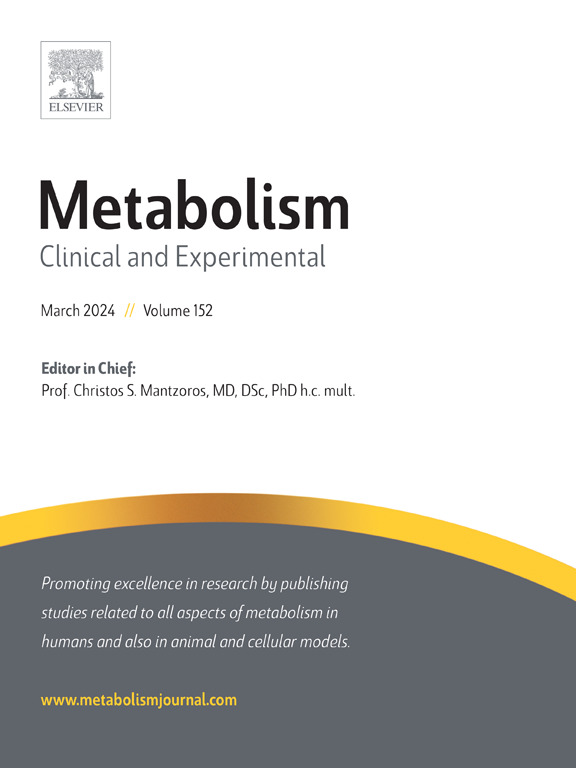Natural selection signatures of 65 syndromic and 8 monogenic obesity genes in 7 ethnic groups do not support the thrifty genotype hypothesis
IF 11.9
1区 医学
Q1 ENDOCRINOLOGY & METABOLISM
引用次数: 0
Abstract
Background
The “thrifty genotype hypothesis” states that gene variants promoting efficient fat deposition may have been advantaged by natural selection to allow human survival during famine. Nowadays, such genes are rendered detrimental by progress as they promote fat deposition in preparation for a famine that never comes, resulting in widespread obesity. Obesity is genetically heterogeneous, with a continuum between very rare syndromic, rare monogenic, and common polygenic forms of obesity. The identification of natural selection signatures has been largely restricted to polygenic obesity-susceptibility variants, and this approach has failed to validate the thrifty genotype hypothesis. However, polygenic variants may not be as relevant as monogenic mutations, characterized by strong phenotypic effects on body mass index variation and obesity risk, in detecting significant signatures of natural selection.
Methods
We investigated the patterns of natural selection of 65 syndromic and 8 monogenic obesity genes in the gnomAD multiethnic population (N = 807,162).
Results
Our data suggest that most dominant syndromic obesity genes display negative signatures of natural selection (i.e., deleterious alleles are selectively purged from the population). In contrast, monogenic obesity genes exhibit neither negative nor positive patterns of natural selection. Our findings do not support the thrifty genotype hypothesis for syndromic and monogenic hyperphagic obesity in 7 ethnic groups.
Conclusion
Our work highlights the evolutionary mechanisms that have shaped the modern ethnic distribution of monogenic and syndromic obesity mutations, why some individuals are susceptible to obesity and have a profound impact on therapeutic strategies for managing chronic diseases.

7个民族65个综合征基因和8个单基因肥胖基因的自然选择特征不支持节俭基因型假说。
背景:“节俭基因型假说”认为,促进脂肪高效沉积的基因变异可能是自然选择的优势,使人类能够在饥荒中生存。如今,这些基因由于进步而变得有害,因为它们促进脂肪沉积,为永远不会到来的饥荒做准备,从而导致普遍的肥胖。肥胖是遗传异质性的,在非常罕见的综合征型、罕见的单基因型和常见的多基因型肥胖之间存在连续性。自然选择特征的识别在很大程度上仅限于多基因肥胖易感性变异,这种方法未能验证节俭基因型假说。然而,在检测自然选择的显著特征方面,多基因变异可能不如单基因突变相关,单基因突变的特点是对体重指数变化和肥胖风险有很强的表型影响。方法:对gnomAD多民族人群(N = 807162) 65个综合征型肥胖基因和8个单基因肥胖基因的自然选择模式进行研究。结果:我们的数据表明,大多数显性综合征型肥胖基因表现出自然选择的负特征(即,有害等位基因被选择性地从人群中清除)。相比之下,单基因肥胖基因既没有表现出自然选择的消极模式,也没有表现出积极模式。我们的研究结果不支持节俭基因型假说在7个民族的综合征和单基因肥厚性肥胖。结论:我们的工作强调了形成单基因和综合征性肥胖突变的现代种族分布的进化机制,为什么一些个体易患肥胖,并对慢性疾病的治疗策略产生深远影响。
本文章由计算机程序翻译,如有差异,请以英文原文为准。
求助全文
约1分钟内获得全文
求助全文
来源期刊

Metabolism: clinical and experimental
医学-内分泌学与代谢
CiteScore
18.90
自引率
3.10%
发文量
310
审稿时长
16 days
期刊介绍:
Metabolism upholds research excellence by disseminating high-quality original research, reviews, editorials, and commentaries covering all facets of human metabolism.
Consideration for publication in Metabolism extends to studies in humans, animal, and cellular models, with a particular emphasis on work demonstrating strong translational potential.
The journal addresses a range of topics, including:
- Energy Expenditure and Obesity
- Metabolic Syndrome, Prediabetes, and Diabetes
- Nutrition, Exercise, and the Environment
- Genetics and Genomics, Proteomics, and Metabolomics
- Carbohydrate, Lipid, and Protein Metabolism
- Endocrinology and Hypertension
- Mineral and Bone Metabolism
- Cardiovascular Diseases and Malignancies
- Inflammation in metabolism and immunometabolism
 求助内容:
求助内容: 应助结果提醒方式:
应助结果提醒方式:


